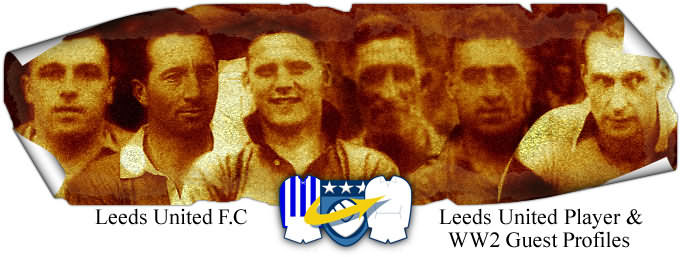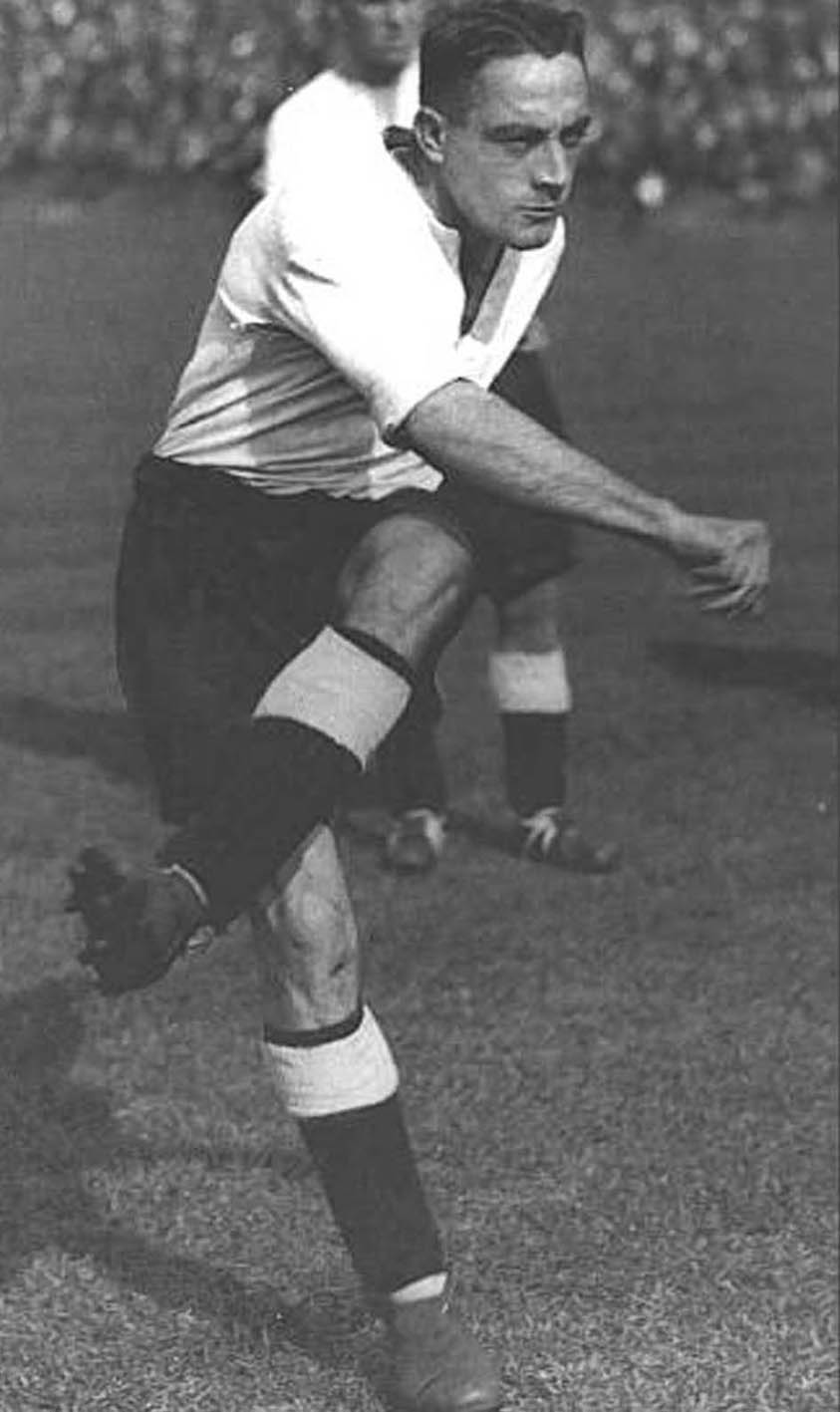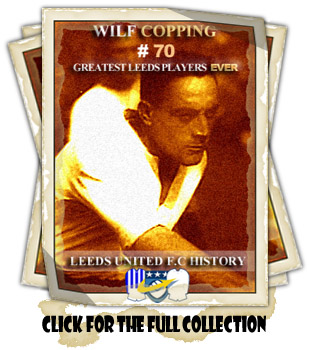

Copping: Wilfred (Wilf)
1930-1934 & 1939-1942
(Player Details)
(Leeds United War-time Guest Player Details)
Left Half
Born: Barnsley: 17-08-1909
Debut: v Portsmouth (h): 30-08-1930
5’7” 10st 3lb (1934)
#70 in 100 Greatest LUFC Players Ever

A pupil of Houghton Council School, he played for Dearne Valley Old Boys and was signed
by First Division Leeds from Middlecliffe Rovers in March 1930 after having a trial with
Second Division Barnsley the year before. “Iron Man” Copping could put opponents off, even
before the kick-off. He rarely shaved before a game and his stubble chin added to the menace
of a man renowned for his bone-jarring tackles. The destructive side of his game brought him
fame but he was scrupulously fair, made excellent use of the ball and was a long-throw
expert. He was ever-present in his first season and became part of the formidable half-back
line of Edwards-Hart-Copping, all of them England players. He won his first cap on 13th May
1933 in a 1-1 draw with Italy in Rome and soon became an England regular making his second
appearance for his country just a week later as England beat Switzerland 4-0 in Berne. His
third cap came in Belfast on 14th October 1933 as Ireland was beaten 3-0, but on the 15th
November Wales beat England 2-1 at Newcastle. He retained his place for the 4-1 win over
France at White Hart Lane on 6th December 1933 and was again part of the team that
defeated the Scots 3-0 at Wembley on 14th April 1934 for his sixth Cap. He also played for
the Football League twice in the 1933-34 season on 4th October 1933 against the Irish League
in a 4-0 win at Deepdale, Preston and on 10th February 1934 in a 2-2 draw with the Scottish
League at Hampden Park. He also took part in two England trial games in that period, when
he played for England against the Rest at Fratton Park, Portsmouth in a 5-1 win on 22nd
March 1933 and for the Rest as they went down to England 1-7 at Roker Park, Sunderland, on
21st March 1934. Copping, apart from his fearsome look, was also a very durable player and
in his first four seasons had only missed nine games for Leeds who had lost their First
Division status at the end of his first season in 1930-31, returning immediately as
Second Division runners-up in 1931-32, and then finished eighth in 1932-33 and ninth in
1933-34. But their success was built around the best half-backline in the country of
Edwards-Hart-Copping. Copping was reknowned and revered by his opponents and Arsenal had
gathered the best team in the land and saw Copping as the last piece in their jigsaw puzzle.
In June 1934, Arsenal signed him for £6,000. In his first spell at Leeds he had scored four
goals in one hundred and fifty-nine League games together with nine F.A. Cup ties. He joined
a team that included players such as Alex James, David Jack, Cliff Bastin, Ted Drake, Joe
Hulme, Eddie Hapgood, Ray Bowden, Frank Moss, Ray John, George Male and Jack Crayston. On
14th November 1934, Copping played for England against World Champions Italy at Highbury in
an England team that included six other Arsenal players. Hapgood, Moss, Bowden, Drake, Bastin
and Male. The game was extremely rough and according to Stanley Matthews: "The game got under
way and from the very first tackles, I was left in no doubt that this was going to be a rough
house of a game. For the first quarter of an hour there might just as well have not been a
ball on the pitch as far as the Italians were concerned. They were like men possessed,
kicking anything and everything that moved bar the referee. The game degenerated into
nothing short of a brawl and it disgusted me." Eddie Hapgood later claimed that " Wilf
Copping enjoyed himself that afternoon. For the first time in their lives the Italians were
given a sample of real honest shoulder charging, and Wilf's famous double-footed tackle was
causing them furiously to think." Stanley Matthews added: "Just before half-time, Wilf Copping
hit the Italian captain Monti with a tackle that he seemed to launch from some where just
north of Leeds. Monti went up in the air like a rocket and down like a bag of hammers and had
to leave the field with a splintered bone in his foot." England also won the game 3-2 though
it mattered little. Copping had carried on being an almost ever-present for his new team,
until 16th March 1935, when he injured his knee at Everton and missed three games in the
season, as he picked up his League Championship medal with Arsenal finishing four points
ahead of second-placed Sunderland. He had picked up his eighth Cap on 6th February 1935 when
England beat Northern Ireland 2-1 at Goodison Park, Liverpool. Arsenal could only finish
fifth in the 1935-36 season but Copping did win an F.A. Cup winner's medal as Arsenal beat
Sheffield United 1-0 in the Final thanks to a goal from Ted Drake. He also picked up two more
England Caps as England went down to Austria 1-2 in Vienna on 6th May 1936 and three days
later were also defeated by Belgium in Brussels, as he brought his total to ten. Copping
picked up his second League Championship medal as Arsenal headed the First Division once more
at the end of the 1937-38 season. He also retained his place in the England team as he won a
further six caps as England won all six games. They beat Norway 6-0 in Oslo on 14th May 1937,
Sweden 4-0 in Stockholm three days later, Finland 8-0 in Helsinki three days after that,
Northern Ireland 5-1 at Windsor Park, Belfast, on 23rd October 1937, Wales 2-1 on 17th
November 1937 at Ayresome Park, Middlesbrough and Czechoslovakia 5-4 on 1st December 1937 at
White Hart Lane. Copping also played in the game against Scotland at Wembley on 9th April 1938,
which Scotland won 1-0. In his autobiography, Bill Shankly, complained about one of Copping's
tackles during the game. "Wilf Copping played for England that day, and he was a well-known
hard man. The grass was short, the ground was quick, and I was playing the ball. The next
thing I knew, Copping had done me down the front of my right leg. He had burst my stocking,
the shin-pad was out, and cut my leg. That was after about ten minutes, and it was my first
impression of Copping." Shankly, who played for Preston North End, was involved in another
incident with Copping the following season. This time Copping injured Shankly's ankle. As
Shankly later pointed out, "For years afterwards I played with my ankle bandaged and wore a
gaiter over my right boot for extra support, and to this day my right ankle is bigger than my
left because of what Copping did. My one regret is that he retired from the game before I had
a chance to get my own back." It is true that Wilf Copping had a reputation for hard-tackling
and acquired the nickname "The Ironman". Copping once said: "The first man in a tackle never
gets hurt." Bill Shankly claimed that Copping was a player who "played the man rather than
the ball". Tommy Lawton also complained about Copping. While playing for Everton in 1938
Lawton constantly beat the Arsenal defenders in the air and Copping warned him that he was
"jumping too high" and that he would have to be "brought down to my level". As Lawton later
recalled: "Sure enough the next time we both went for a cross, I end up on the ground with
blood streaming from my nose. Wilf was looking down at me and he said 'Ah told thee, Tom.
Tha's jumping too high!' My nose was broken. When Arsenal came to Everton, Copping broke my
nose again! He was hard, Wilf. You always had something to remember him by when you played
against him." Jeff Harris argues in his book, "Arsenal Who's Who (1995)" that Copping "had
the legendary reputation of being more than forceful in the tackle. And that he was the
first to admit that he was temperamental and fiery his bone-jarring tackles were mainly
timed to perfection and fair". Harris adds that proof that Copping was a clean player is
the fact that he played in three hundred and forty League games and was never cautioned or
sent-off during his career. He played in his eighteenth and nineteenth game for England in
October 1938, when England were beaten 2-4 by Wales at Ninian Park, Cardiff, but four days
later they beat the Rest of Europe 3-0 at Highbury. In March 1939, Copping asked Arsenal
for a transfer. He told the manager that he felt "a war is coming and I want to get my wife
and kids back up North before I join the army." Copping was allowed to rejoin Leeds United
and during the Second World War he served in North Africa. With Arsenal he had played one
hundred and sixty-six League games, together with nineteen F.A. Cup ties, for them before
his return to Leeds. He gain his twentieth and final England cap on 24th May 1939, when
England beat Romania 2-0 in Bucharest. He also played for England in a War-time International
at Wembley on 13th April 1940 when Wales won 1-0. In the time that he was back at Leeds
before the War brought the Football League fixtures to a temporary end he played twelve
games at Left Half in the 1938-39 season and had played all three games of the 1939-40
season before it was aborted. During the War he played twenty-four games for Leeds,
scattered over three seasons, when on leave from the Army, before retiring in 1942. In the
Army he served as a Company Sergeant-Major Instructor in North Africa. Copping also made
guest appearances for several other clubs during the Second World War. In 1939-40 he played
five games for Aldershot, once for Hartlepools United and once for Middlesbrough in 1940-41
he played nine games for Doncaster Rovers and twice for Nottingham Forest. He played three
games for Arsenal in 1942-43, and twice for Fulham, who he returned to play twice more
for in 1943-44. He also played many games for and against military teams. He played for a
combined Aldershot and Army team that was beaten 1-0 by an F.A. XI at Aldershot on 18th
October 1939 in front of a crowd of 10,000. On 20th January 1940 he played for an England
XI against The Army, as they won 4-3 at Selhurst Park in front of 10,057. He was in France
on 15th February to represent the Army against the French Army in a 1-0 win in Lille with
a crowd of 13,000 on hand. A crowd of 14,205 was at Anfield to see him play for The Army in
a 5-2 win over a Football League XI. He played at Tynecastle, Edinburgh, for The Army who
were beaten by a Scottish XI on 24th April 1940. It was almost two years before he again
represented The Army in a 1-1 draw against the RAF at Aldershot on 14th February 1942. He
next played for an F.A. XI against the Army as a crowd of 10,000 was in attendance at
Aldershot a month later. Aldershot was again the venue as he again represented the Army in
a 5-5 draw with the Metropolitan Police on 2nd January 1943 and couple of weeks later on
20th January he played for a Stan Cullis XI as they took on the same opposition and Copping
scored in a 5-1 victory at Chichester. The rest of his games were for Army XIs as they took
on the Belgian Army in a 5-0 win at Aldershot on 6th March 1943, then on 27th March 1943,
6,000 watched as there was an 11-0 win over the USA Army on 27th March 1943 at the Dell,
Southampton, and at the same venue there was the same score and attendance against the
Norwegian Forces on 3rd April 1943. He was the trainer of the Army XI in Dusseldorf in 1945,
then coached Royal Beerschot Antwerp and the Belgian national team. He became trainer at
Southend United in 1946, Bristol City in July 1954 and Coventry City from November 1956
until May 1959. A keen wireless enthusiast, he worked at Ford’s Dagenham and later lived
at Prittlewell, near Southend, where he died in June 1980. In 1998, the Football League,
as part of its centenary season celebrations, included Copping on its list of
"100 League Legends".
| Appearances | Goals |
| League 174 | 4 |
| F.A. Cup 9 | 0 |
| War-time: | |
| League 24 | 0 |
| Cup 4 | 0 |